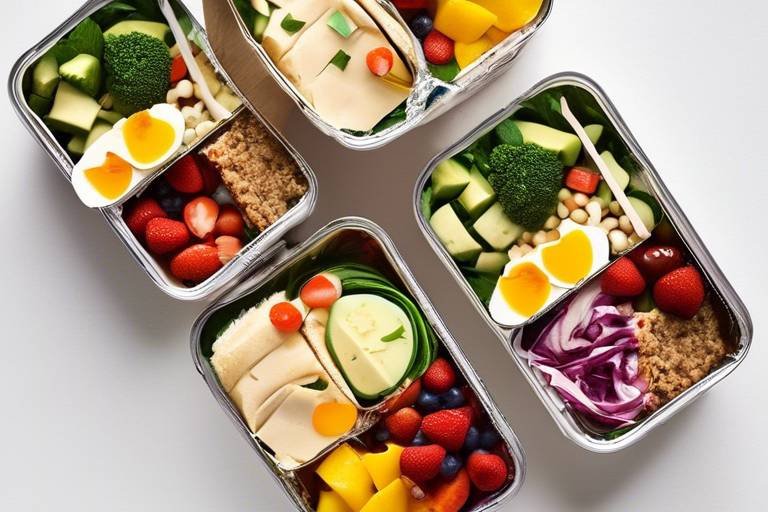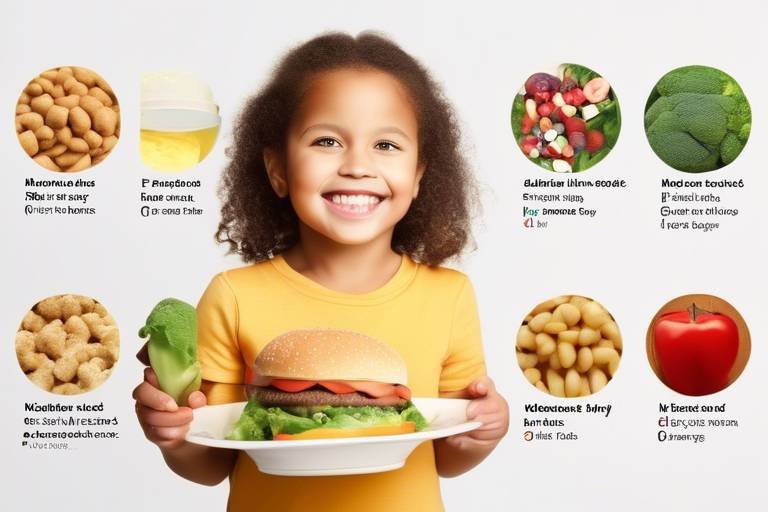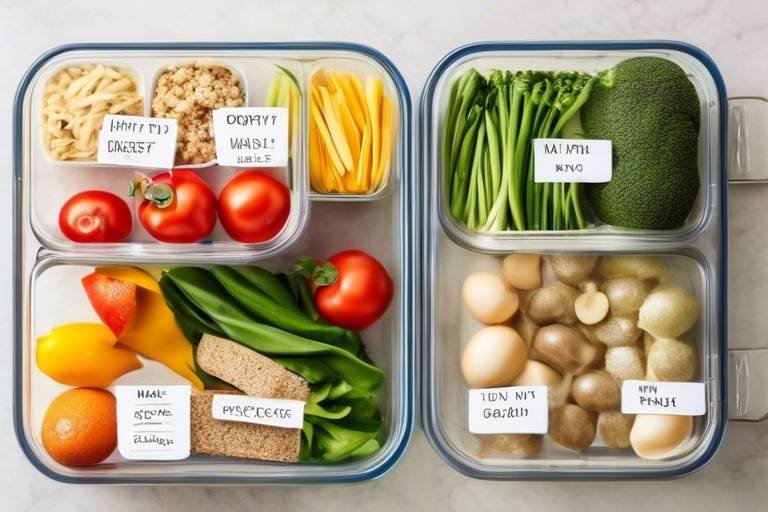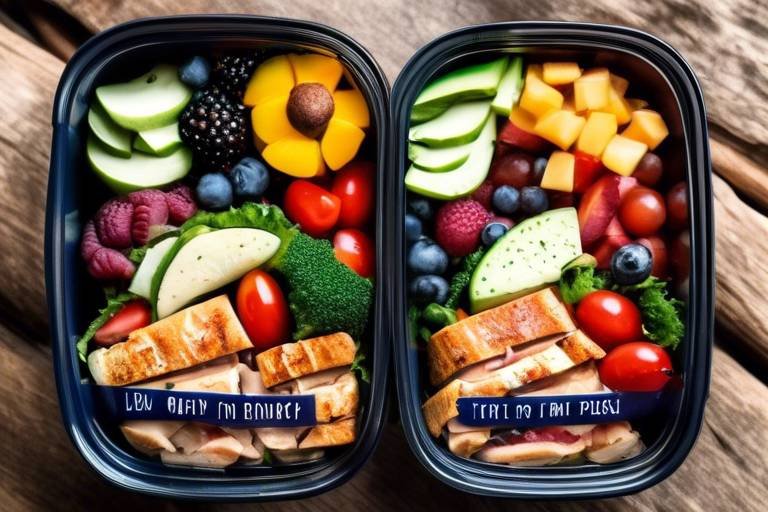The Challenge of Feeding Picky Eaters: Creative Solutions
Feeding picky eaters can feel like navigating a culinary minefield, can't it? One moment, your child might be gobbling down broccoli like it's candy, and the next, they're turning their nose up at the same vegetable, as if it's a plate of slime. This rollercoaster of preferences can leave parents feeling frustrated and overwhelmed. But fear not! There are creative solutions that can help turn mealtime into a more enjoyable experience for both parents and their little ones. In this article, we’ll explore innovative strategies and tips that can help you successfully navigate the complexities of feeding picky eaters while encouraging healthy eating habits.
Picky eating is a common phase in childhood development, but it can be a source of stress for parents. Understanding the psychological and developmental factors that contribute to this behavior is key. Children are naturally curious, and their taste buds are still developing. This can lead to strong preferences and aversions to certain foods. For instance, did you know that children are more sensitive to bitter flavors? This sensitivity can result in them rejecting vegetables or other foods that have a strong taste. By recognizing these developmental stages, parents can approach mealtime with more empathy and patience, knowing that this behavior is often temporary.
Every child has unique nutritional requirements, which can complicate feeding picky eaters. It’s essential to identify the key nutrients your child needs for growth and development, even if they have a limited palate. Essential nutrients include proteins, carbohydrates, fats, vitamins, and minerals. To ensure your picky eater receives a balanced diet, consider keeping a food diary to track what your child eats. This can help you pinpoint any nutritional gaps. For instance, if your child is avoiding fruits and vegetables, you might need to find alternative sources of vitamins and minerals. Here’s a quick breakdown of some critical nutrients and their food sources:
| Nutrient | Food Sources |
|---|---|
| Protein | Chicken, beans, eggs, yogurt |
| Calcium | Milk, cheese, leafy greens |
| Iron | Red meat, lentils, spinach |
| Fiber | Whole grains, fruits, vegetables |
Understanding macronutrients and micronutrients is crucial for a child's growth. Macronutrients—proteins, fats, and carbohydrates—provide the energy needed for daily activities, while micronutrients—vitamins and minerals—support various bodily functions. Incorporating these nutrients into meals for picky eaters can be a challenge, but it doesn’t have to be bland or boring. Think of meals as a canvas and your ingredients as the paint. You can create vibrant, nutritious dishes that appeal to your child's taste buds without compromising on health.
Using innovative cooking methods can transform meals from mundane to magical. For example, roasting vegetables can enhance their natural sweetness, making them more appealing to a picky eater. Try making sweet potato fries or zucchini chips—these can be fun finger foods that kids love! Experimenting with different cooking techniques, such as grilling, steaming, or even blending, can help you discover new flavors and textures that your child might enjoy.
One effective strategy for feeding picky eaters is to incorporate hidden veggies into familiar dishes. This can be a game changer! For example, you can blend spinach into a smoothie, mix grated carrots into spaghetti sauce, or add pureed cauliflower to mashed potatoes. The goal is to sneak in those nutritious ingredients without your picky eater even noticing. This not only boosts their nutrient intake but also helps them develop a taste for these foods over time.
Engaging children during mealtime can encourage them to try new foods. Think of mealtime as a mini-adventure! You can create themed dinners, such as “Taco Night” where kids can build their own tacos with various toppings. This interactive approach makes eating more enjoyable and can spark curiosity about different foods. Additionally, involving children in the cooking process can make them more invested in what they eat. Let them help wash vegetables, stir ingredients, or even set the table. When children feel like they have a hand in the meal, they are often more willing to try what's on their plate.
Introducing new foods to picky eaters can be daunting, but it doesn’t have to be a battle. One effective strategy is to introduce new foods gradually. Start by pairing a new food with a familiar favorite. For example, if your child loves macaroni and cheese, try adding a small amount of broccoli to the dish. This way, the new food is less intimidating, and your child might be more willing to give it a try. Remember, it can take multiple exposures to a new food before a child is willing to accept it.
Children often model their behavior after peers, so why not use this to your advantage? Involving friends or siblings in mealtime can encourage picky eaters to try new foods through social influence. If they see their friends enjoying a variety of foods, they might be more inclined to join in. Organizing playdates that include meals can create a relaxed atmosphere where trying new foods feels less pressured.
The dining atmosphere plays a significant role in a child's willingness to eat. Establishing a calm and inviting environment can foster open-mindedness toward food. Try to minimize distractions during mealtime, such as turning off the TV or putting away devices. Instead, focus on conversation and connection. Encourage your child to express their thoughts about the food they're trying—this can help them feel more in control and engaged.
- What should I do if my child refuses to eat new foods?
Be patient and persistent. It often takes several exposures to a new food before a child will accept it. Try pairing new foods with favorites. - How can I ensure my picky eater gets enough nutrients?
Keep a food diary to track nutrient intake and consider incorporating hidden veggies into familiar dishes. - Is it okay to let my child skip meals?
While occasional skipped meals are normal, ensure that your child has access to healthy snacks throughout the day.

Understanding Picky Eating
Picky eating is not just a quirk; it’s a common phase in childhood development that many parents face. Imagine this: you prepare a delicious meal, filled with vibrant colors and enticing aromas, only to have your little one turn their nose up at it. Frustrating, right? But understanding why children become picky eaters can help ease the stress that comes with mealtime. There are several psychological and developmental factors at play, and by recognizing them, parents can navigate this challenging phase with more confidence and creativity.
Firstly, it's important to note that picky eating is often a natural response to the overwhelming variety of tastes and textures in food. Children are innately cautious about trying new things—this instinct has roots in evolutionary biology, where being wary of unfamiliar foods helped our ancestors avoid potential dangers. So, when your child refuses to eat a new vegetable, it might not be defiance; it could simply be their instinct kicking in!
Moreover, developmental milestones can also contribute to picky eating. As children grow, they develop a sense of autonomy and personal preference. They may begin to assert their independence by rejecting foods they previously enjoyed. This is completely normal and can be seen as a way for them to express themselves. Think of it as them testing the waters of their choices in the big world of flavors.
Additionally, sensory sensitivities play a significant role in picky eating. Children may have heightened sensitivity to certain textures, flavors, or even the smell of food. For instance, a child might love the taste of broccoli but refuse to eat it because they dislike its texture. This sensory aspect can be a real barrier, making it crucial for parents to be patient and understanding.
Another factor to consider is the influence of social dynamics. Children are keen observers of their surroundings and often mimic the eating habits of their peers or family members. If they see others enjoying a particular food, they may be more inclined to give it a try. Conversely, if they notice a family member expressing disgust towards a food item, they might adopt that same aversion. This highlights the importance of modeling healthy eating habits in front of your children.
In summary, understanding picky eating involves considering a mix of biological instincts, developmental milestones, sensory sensitivities, and social influences. By recognizing these factors, parents can approach mealtime with more empathy and creativity. Instead of seeing a refusal to eat as a battle to be won, it can be viewed as an opportunity to explore new flavors and textures together. Remember, patience is key, and with time, even the pickiest of eaters can learn to enjoy a wider variety of foods!

Identifying Nutritional Needs
Every child is unique, and so are their nutritional requirements. As parents and caregivers, it’s essential to become detectives of sorts, investigating what our picky eaters need to thrive. The journey of identifying these needs can be a bit like piecing together a puzzle, where each piece represents a different nutrient essential for your child's growth and development. But don't worry; you're not alone in this quest!
First off, let's talk about the **macronutrients**: carbohydrates, proteins, and fats. These are the big players in your child's diet, providing the energy and building blocks necessary for growth. Carbohydrates are like the fuel for a car, giving your child the energy to run, play, and learn. Meanwhile, proteins are crucial for muscle development and repair, acting as the construction workers of the body. Lastly, healthy fats are vital for brain development, much like how oil keeps machinery running smoothly. Understanding how to balance these macronutrients is key to ensuring your child gets what they need, even if they have a limited palate.
Now, let’s not forget about **micronutrients**—the vitamins and minerals that are equally important. These nutrients, though needed in smaller amounts, play a significant role in your child's overall health. For instance, vitamin A supports vision and immune function, while calcium is essential for strong bones and teeth. Iron is another critical nutrient, especially for growing children, as it helps in the formation of red blood cells. But how do you ensure your picky eater gets enough of these vitamins and minerals? This is where creativity comes into play!
To help you visualize the nutritional needs of your child, here’s a simple table that outlines some key nutrients and their benefits:
| Nutrient | Importance | Sources |
|---|---|---|
| Carbohydrates | Energy source for daily activities | Whole grains, fruits, vegetables |
| Proteins | Muscle growth and repair | Meat, fish, eggs, beans |
| Fats | Brain development and energy | Nuts, seeds, avocados, olive oil |
| Vitamins | Support immune function, vision, etc. | Fruits, vegetables, dairy |
| Minerals | Bone health, oxygen transport | Leafy greens, dairy, meats |
As you can see, each nutrient plays a unique role, and it's crucial to incorporate a variety of foods into your child's diet to cover all bases. But how do you do this with a picky eater? You might need to think outside the box! For instance, blending fruits into smoothies or making whole grain pancakes can be a fun way to sneak in those essential nutrients without overwhelming your child. Remember, the goal is to create a balanced diet that meets their nutritional needs while still being enjoyable.
In conclusion, identifying your child's nutritional needs is a vital step in ensuring they grow up healthy and strong. By understanding the importance of both macronutrients and micronutrients, you can make informed decisions about their diet. And while it may feel like a challenge, with creativity and patience, you can help your picky eater develop a more varied and nutritious diet.
- What are the signs of a picky eater? A picky eater may refuse to try new foods, have a limited selection of preferred foods, or show strong preferences for certain textures or colors.
- How can I encourage my child to try new foods? Introduce new foods gradually, involve them in meal preparation, and make mealtime a fun and relaxed experience.
- Are there specific nutrients I should focus on for picky eaters? Yes, focus on ensuring they receive adequate protein, iron, calcium, and vitamins A and C, as these are crucial for growth and development.

Balancing Macros and Micros
When it comes to feeding picky eaters, understanding the balance of macronutrients and micronutrients is crucial for their overall health and development. Macronutrients, which include carbohydrates, proteins, and fats, are essential for providing energy and supporting growth. On the other hand, micronutrients, such as vitamins and minerals, play a vital role in various bodily functions, including immune support and bone health. So, how can parents ensure their picky eaters receive these important nutrients without turning mealtime into a battlefield?
First, let’s break it down a bit. Think of macronutrients as the building blocks of your child’s diet. For instance, carbohydrates are like fuel for a car, giving kids the energy they need to run, play, and learn. Proteins are the repair crew, helping to build and maintain muscles, while fats serve as the long-lasting energy source. It’s important to include a variety of foods that provide these nutrients. But, with picky eaters, this can feel like an uphill battle!
To make things easier, consider this simple table that outlines some common food sources for each macronutrient:
| Macronutrient | Food Sources |
|---|---|
| Carbohydrates | Whole grains, fruits, vegetables, legumes |
| Proteins | Lean meats, fish, eggs, dairy, beans, nuts |
| Fats | Avocados, olive oil, nuts, seeds, fatty fish |
Now, let’s not forget about those micronutrients. These tiny but mighty nutrients can often be overlooked, especially in a picky eater's limited diet. They are found in fruits and vegetables, which many children may shy away from. However, introducing a colorful array of fruits and veggies can help. Think of it as painting a picture; the more colors you use, the more vibrant and appealing it becomes! Aim for a rainbow on the plate, as different colors often represent different nutrients.
One effective way to incorporate both macros and micros is through creative cooking techniques. For example, try making a smoothie that combines spinach (a great source of iron and vitamins) with bananas (for potassium and energy) and yogurt (for protein and calcium). This not only masks the taste of the greens but also provides a delicious treat that kids will love! By blending these ingredients together, you create a nutritious drink that satisfies their taste buds while delivering essential nutrients.
Another strategy is to involve your child in meal preparation. Kids are often more willing to try foods they have helped make. Whether it’s rolling out dough for whole grain pizza or choosing toppings for a colorful salad, participation can spark interest in new foods. You can explain the benefits of each ingredient, making it a fun and educational experience. This way, they learn the importance of a balanced diet while also feeling empowered in their food choices.
So, the key takeaway here is to be creative and patient. Balancing macros and micros doesn’t have to be a chore. With a little ingenuity and a sprinkle of fun, you can transform mealtime into an exciting adventure for your picky eater. Remember, it’s all about making food enjoyable while ensuring they get the nutrition they need to grow strong and healthy!

Creative Cooking Techniques
When it comes to feeding picky eaters, creativity in the kitchen can work wonders. Think of cooking as an art form, where each meal is a canvas waiting for your unique touch. Instead of viewing mealtime as a battle, why not turn it into an exciting adventure? One of the most effective ways to get children to embrace healthy foods is by using innovative cooking techniques that not only enhance flavor but also make the food visually appealing.
For instance, consider the power of color. Children are naturally drawn to vibrant colors, so why not incorporate a rainbow of fruits and vegetables into their meals? A simple stir-fry loaded with colorful bell peppers, carrots, and broccoli can be more enticing than a plain bowl of pasta. You can even create a colorful smoothie using spinach, bananas, and berries, which not only looks delightful but also packs a nutritional punch. The key is to make the food as visually appealing as possible, transforming ordinary dishes into exciting masterpieces.
Another technique that can work wonders is textural variety. Picky eaters often have strong preferences for certain textures, so mixing things up can help. For example, if your child loves crunchy foods, try adding some toasted nuts or seeds to a salad or yogurt. On the other hand, if they prefer softer textures, you might experiment with pureeing vegetables into soups or sauces. The contrast of textures can make a meal feel like a fun experience rather than a chore.
Moreover, don't underestimate the power of fun shapes. Using cookie cutters to create fun shapes out of sandwiches or fruits can make the meal more exciting. Imagine a star-shaped cucumber slice or a heart-shaped sandwich! Not only does this spark joy, but it also encourages children to explore different foods without feeling overwhelmed. You can also use molds for freezing smoothies or yogurt, creating fun pops that are both healthy and enjoyable.
For those who enjoy a bit of theatrics, consider incorporating cooking techniques that involve the child in the process. Cooking together can make children more invested in what they eat. Techniques like stir-frying, where kids can toss ingredients into the pan, or assembling their own tacos can be a hit. When they take part in the preparation, they are more likely to be curious about the flavors and willing to try the final product.
Finally, always remember that presentation matters. A well-plated meal can be more appealing than a haphazardly thrown-together dish. Use colorful plates and arrange the food in a way that tells a story or creates a scene. For example, you can create a “garden” on the plate with mashed potatoes as soil, peas as grass, and a carrot stick as a tree. This playful approach not only makes meals exciting but also encourages children to dig in and explore new tastes.
In summary, by employing these creative cooking techniques, you can transform mealtime from a struggle into a delightful experience. Remember, the goal is to make healthy eating fun and engaging, turning picky eaters into adventurous food explorers!

Incorporating Hidden Veggies
Getting picky eaters to consume their vegetables can feel like trying to convince a cat to take a swim—nearly impossible! But fear not, there are creative ways to sneak those nutrient-packed veggies into meals without raising any red flags. The key is to be both clever and subtle. Think of it as a culinary magic trick where the "rabbit" is a serving of broccoli or spinach, and the "hat" is your child’s favorite pasta dish!
One effective method is to blend vegetables into sauces. For instance, adding pureed carrots or zucchini to tomato sauce can enhance the flavor and texture while providing essential vitamins. You can also mix spinach or kale into smoothies, where the fruit's sweetness masks the taste of the greens. This not only boosts the nutritional value but also makes it easier for your little ones to enjoy something they might otherwise reject.
Another fun approach is to create vegetable-infused snacks. Consider baking muffins that incorporate shredded zucchini or carrots. They can be sweetened with bananas or applesauce, making them not only delicious but also a sneaky way to get in those veggies. You might also try making veggie chips from kale or sweet potatoes, which can serve as a crunchy alternative to traditional snacks.
When it comes to meals, think about hiding veggies in familiar dishes. For example, you can add finely chopped bell peppers or onions to meatballs or burgers. The flavors blend together so well that your child may never know they’re eating their veggies! Additionally, consider making a veggie-packed quesadilla loaded with cheese, where the veggies become part of the delicious filling rather than the main event.
To keep track of which hidden veggies work best, you might find it helpful to create a hidden veggie chart. Here’s a simple example:
| Dish | Hidden Veggie | Preparation Method |
|---|---|---|
| Tomato Sauce | Pureed Carrots | Blend and mix |
| Smoothie | Spinach | Blend with fruits |
| Muffins | Shredded Zucchini | Mix into batter |
| Meatballs | Finely Chopped Bell Peppers | Mix into meat mixture |
Remember, the goal is to make veggies a normal part of their diet without the fuss. By incorporating hidden veggies into meals, you’re not only helping your child meet their nutritional needs but also teaching them that healthy food can be delicious and satisfying. As they grow, they may even surprise you by asking for those veggies outright!

Making Mealtime Fun
Mealtime can often feel like a battleground, especially when faced with a picky eater. But what if I told you that transforming this daily chore into a fun and engaging experience is possible? Yes, you heard that right! By incorporating a few creative strategies, you can make mealtime an adventure rather than a struggle. Think of it as turning a mundane task into a delightful game that your child will look forward to.
One of the simplest ways to spice up mealtime is by introducing themed dinners. For instance, you could have a “Taco Tuesday” where everyone builds their own tacos. This not only allows your child to choose their ingredients but also encourages them to experiment with new flavors. You can even take it a step further by introducing different themes each week, like “Italian Night” or “Breakfast for Dinner.” The excitement of a new theme can make your child more willing to try new foods.
Another fantastic idea is to create a food art station. Kids love to play with their food, so why not embrace that? Set up a station where they can create fun shapes or faces using fruits, vegetables, and other healthy ingredients. Imagine a plate adorned with a smiley face made from cucumber slices and cherry tomatoes! Not only does this encourage creativity, but it also makes healthy eating visually appealing. Plus, when children are involved in the preparation process, they often feel more invested in the meal and are more likely to try what they’ve helped create.
Incorporating games into mealtime can also work wonders. Try playing a game where each family member shares their favorite food and why they love it. This not only opens up discussions about food preferences but also normalizes trying new things. You can even introduce a “try-it” challenge where everyone needs to taste a new dish; if they don’t like it, they can pass, but they must try something new next time. This takes the pressure off while still encouraging exploration.
Don’t forget the power of music and ambiance. Setting the mood with upbeat music can make mealtime feel like a celebration rather than a chore. You could even create a fun playlist together that features their favorite songs. The idea is to create an atmosphere that is relaxed and joyful, where trying new foods feels like part of a fun experience rather than an obligation.
Lastly, consider involving your child in the planning process. Let them help you choose recipes or pick out fruits and vegetables at the grocery store. This gives them a sense of control and ownership over their meals, making them more likely to eat what they’ve chosen. You could create a simple chart at home where they can mark off the foods they want to try each week. The more involved they feel, the more open they will be to tasting new flavors.
In conclusion, making mealtime fun is all about creativity and engagement. By transforming food into an enjoyable experience, you can help your picky eater develop a more positive relationship with food. Remember, the goal is to create a nurturing environment where trying new things is celebrated, not feared. So, roll up your sleeves, unleash your imagination, and watch as mealtime becomes a highlight of your day!
- What are some tips for getting my child to try new foods? Start by introducing new foods alongside familiar favorites, and make the experience fun and engaging.
- How can I encourage my picky eater to eat vegetables? Try incorporating vegetables into dishes they already enjoy, or use creative cooking techniques to enhance their appeal.
- Is it normal for children to be picky eaters? Yes, many children go through phases of picky eating as part of their development.
- What should I do if my child refuses to eat? Stay calm and avoid pressure. Offer a variety of foods and allow them to explore at their own pace.

Strategies for Introducing New Foods
Introducing new foods to picky eaters can feel like trying to convince a cat to take a bath—challenging and often met with resistance. However, with a little creativity and patience, you can turn this daunting task into an exciting adventure for your child. The key lies in understanding their unique tastes and preferences while gently nudging them toward trying new flavors and textures.
One effective strategy is to start small. Instead of overwhelming your child with an entirely new dish, consider incorporating tiny portions of unfamiliar foods alongside their favorites. For example, if your child loves macaroni and cheese, you might add a sprinkle of broccoli or a few peas on the side. This way, they can explore new tastes without feeling pressured. Sometimes, it’s about familiarizing them with the appearance and smell of the food first, which can make them more open to tasting it later.
Another fun approach is to involve your child in the cooking process. Children are often more willing to try foods they’ve helped prepare. You can set up a mini cooking class at home where they can wash vegetables, mix ingredients, or even choose the spices. This hands-on experience not only makes them feel empowered but can also spark their curiosity about new foods. As they see their creation come to life, they may be more inclined to give it a taste. Plus, cooking together can be a fantastic bonding experience!
Peer influence can also play a significant role in expanding a picky eater's palate. Children are naturally curious and often look to their friends or siblings for cues. Organizing playdates or family meals where everyone tries new foods can create a supportive environment for your child. Imagine them watching their friends eagerly munching on a colorful veggie platter—this can ignite a spark of curiosity and encourage them to join in. You might even create a fun challenge, like a “taste test” where everyone tries a new food and rates it, turning the experience into a game.
Creating a positive eating environment is crucial as well. The atmosphere during mealtime can significantly impact a child's willingness to try new foods. Aim for a calm, relaxed setting where distractions are minimized. Turn off the TV, put away devices, and engage in enjoyable conversations. This not only fosters a sense of security but also encourages open-mindedness regarding food. You might even consider themed dinners where you explore different cuisines together, making each meal a delightful experience rather than a chore.
Lastly, don't underestimate the power of patience and persistence. It’s perfectly normal for children to reject new foods multiple times before accepting them. Research suggests that it can take up to 15 exposures for a child to become comfortable with a new food. So, keep offering those new foods without pressure or negativity. Celebrate small victories, like a single bite or a curious sniff, and maintain a positive attitude. Remember, every child is different, and what works for one might not work for another. Tailor your approach to suit your child's personality and preferences.
In summary, introducing new foods to picky eaters doesn't have to be a battle. By employing these strategies—starting small, involving your child in cooking, leveraging peer influence, creating a positive environment, and practicing patience—you can help your child develop a more adventurous palate over time. It’s all about making the experience enjoyable and engaging, transforming mealtime into a delightful exploration rather than a daunting task.
- How do I deal with food refusal? - It's important to stay calm and avoid forcing your child to eat. Instead, encourage them to try just one bite and praise their efforts.
- What if my child only wants to eat junk food? - Gradually introduce healthier options by pairing them with favorite junk foods, creating a balance that feels comfortable.
- How can I make vegetables more appealing? - Try roasting, blending, or incorporating them into familiar dishes like smoothies or sauces to enhance their flavors.

Using Peer Influence
Have you ever noticed how children are like little sponges, soaking up everything around them? They watch, they mimic, and they learn from their peers. This peer influence can be a powerful tool when it comes to encouraging picky eaters to broaden their culinary horizons. Imagine a scenario where your child is at a friend’s house, and they see their buddy devouring a colorful plate of veggies. Suddenly, those same veggies that were once met with scrunched noses at home might just look a little more appealing. It's fascinating how the social dynamics of childhood can shift a child's perspective on food.
To harness this natural tendency, consider organizing playdates or family meals where children can enjoy meals together. The more relaxed and fun the environment, the more likely they are to try new foods. You could even turn mealtime into a mini cooking class where kids can help prepare the food. When they’re involved in the cooking process, they often feel a sense of ownership and pride in what they’re eating. Plus, it’s a great way to sneak in some education about healthy eating!
Another effective strategy is to create a food tasting party where kids can sample a variety of foods in a low-pressure setting. You can set up a colorful buffet with a range of options, from fruits to veggies to whole grains. Encourage them to try everything by making it a fun challenge. You might say, “Let’s see who can find the most colorful food on their plate!” This playful competition not only makes trying new foods exciting but also promotes a sense of camaraderie among the children.
To further enhance the impact of peer influence, consider the following tips:
- Invite Friends Over: Having friends over for dinner can create a relaxed environment where children feel more inclined to try what others are eating.
- Encourage Sharing: Kids love to share and swap bites of their food. This can lead to them trying something new just because their friend is enjoying it.
- Model Positive Eating: When children see their peers enjoying a variety of foods, they may be more willing to join in. Positive reinforcement from friends can be incredibly motivating.
Incorporating peer influence into mealtime not only helps picky eaters expand their palates but also fosters a positive social experience around food. It’s all about creating an environment where trying new foods feels less like a chore and more like an adventure. So, the next time you’re planning a meal, think about how you can leverage the power of friendship to make eating a fun and inclusive experience!
Q: How can I encourage my child to try new foods without forcing them?
A: One effective way is to involve them in meal preparation. When they help cook, they may be more inclined to taste what they’ve made. Also, create a positive atmosphere during meals and celebrate small victories when they try something new.
Q: What if my child refuses to eat anything but a few specific foods?
A: It’s important to maintain a balanced approach. Continue to offer a variety of foods without pressure. Sometimes, it takes multiple exposures to a new food before a child is willing to try it. Patience is key!
Q: Are there specific foods that are better for picky eaters?
A: Focus on nutrient-dense foods that can be easily incorporated into meals, such as smoothies, which can hide fruits and veggies, or whole grain pastas that can be mixed with sauces they already enjoy.

Creating a Positive Eating Environment
Creating a positive eating environment is crucial for encouraging picky eaters to explore new foods. Think of mealtime as a stage where the actors (your children) can shine. If the atmosphere is filled with tension or distractions, it’s like trying to watch a movie with constant interruptions—no one enjoys it! To foster a welcoming and enjoyable dining experience, consider the following elements:
First and foremost, the setting matters. A cluttered table or a noisy background can distract children from their food. Try to create a calm and inviting space. Use soft lighting, perhaps a tablecloth, and make sure the dining area is tidy. You might even let your child help set the table; this involvement can make them feel more connected to the meal. When they have a hand in preparing the environment, they’re more likely to be excited about what’s to come.
Next, consider the company. Eating together as a family can transform mealtime from a chore into a cherished ritual. Engage in light-hearted conversation, share stories, and avoid discussing negative topics. This can make children feel safe and more willing to try new foods. You might even want to introduce a fun tradition, like “Foodie Fridays,” where each family member picks a new dish to try together. This not only diversifies their palate but also builds anticipation for mealtime.
Another essential factor is to minimize distractions. Turn off the television, put away phones, and focus on each other and the food. When children are not distracted, they can pay attention to their meals and their own hunger cues. This can help them learn to listen to their bodies, which is an important skill for developing healthy eating habits.
Lastly, consider the presentation of food. Kids are visual creatures, and a plate that looks appealing can spark their interest. Use colorful ingredients and creative arrangements to make the meal look like a work of art. For example, you can create a smiley face with fruits and veggies or arrange food in fun shapes. This not only makes the meal more enticing but also encourages children to dive in and explore the flavors.
In summary, creating a positive eating environment involves thoughtful planning around the setting, the company, minimizing distractions, and the presentation of food. By transforming mealtime into a joyful experience, you pave the way for your picky eaters to develop a more adventurous palate and a healthier relationship with food.
- What should I do if my child refuses to eat? It's essential to remain calm and avoid power struggles. Offer choices and encourage them to try just a bite without pressure.
- How can I encourage my child to try new foods? Introduce new foods gradually, perhaps alongside familiar favorites, and make it a fun challenge rather than a chore.
- Is it okay to bribe my child to eat? Instead of bribing, try positive reinforcement. Praise them for trying new foods and involve them in the cooking process.
Frequently Asked Questions
- What causes picky eating in children?
Picky eating is often a normal phase in childhood development. Factors such as natural food neophobia, sensory sensitivities, and a desire for control can contribute to this behavior. Understanding these factors can help parents navigate this challenging phase.
- How can I ensure my picky eater gets enough nutrients?
Identifying essential nutrients is key. Focus on incorporating a variety of foods that are rich in vitamins and minerals. You can also consider supplements if necessary, but it’s always best to consult with a pediatrician before making changes to your child's diet.
- What are some creative cooking techniques to make meals appealing?
Using methods like roasting, blending, or spiralizing can enhance the flavor and texture of foods. Experimenting with different spices and herbs can also make a significant difference. The goal is to make healthy foods more enticing without compromising on taste!
- How can I sneak vegetables into my child's meals?
Hiding vegetables can be effective! Try blending spinach into smoothies, adding grated carrots to pasta sauces, or incorporating pureed veggies into baked goods. The key is to use familiar dishes that your child already enjoys.
- What strategies help in introducing new foods?
Gradual exposure is important. Start by offering small portions of new foods alongside familiar favorites. You can also involve siblings or friends during mealtime, as children often feel encouraged to try new foods when they see their peers enjoying them.
- How can I create a positive eating environment?
A calm and inviting atmosphere is crucial. Minimize distractions, set a pleasant table, and engage in positive conversation during meals. This helps foster a relaxed environment where children feel more open to trying new foods.



















